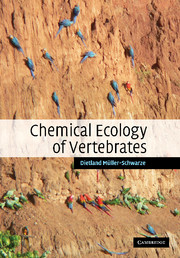Book contents
- Frontmatter
- Contents
- Preface
- Acknowledgements
- 1 The odorsphere: the environment for transmission of chemical signals
- 2 Properties of vertebrate semiochemicals
- 3 Odor production and release
- 4 Chemical cues in orientation and navigation
- 5 Chemoreception
- 6 Signaling pheromones I: discrimination and recognition
- 7 Signaling pheromones II: sex and alarm pheromones and evolutionary considerations
- 8 Intraspecific signals: priming pheromones
- 9 Development of intra- and interspecific chemical communication
- 10 Allomones I: chemical defense by animals
- 11 Allomones II: plant chemical defenses against herbivores
- 12 Kairomones and synomones
- 13 Practical applications of semiochemicals
- Glosssary
- References
- Index
2 - Properties of vertebrate semiochemicals
Published online by Cambridge University Press: 23 November 2009
- Frontmatter
- Contents
- Preface
- Acknowledgements
- 1 The odorsphere: the environment for transmission of chemical signals
- 2 Properties of vertebrate semiochemicals
- 3 Odor production and release
- 4 Chemical cues in orientation and navigation
- 5 Chemoreception
- 6 Signaling pheromones I: discrimination and recognition
- 7 Signaling pheromones II: sex and alarm pheromones and evolutionary considerations
- 8 Intraspecific signals: priming pheromones
- 9 Development of intra- and interspecific chemical communication
- 10 Allomones I: chemical defense by animals
- 11 Allomones II: plant chemical defenses against herbivores
- 12 Kairomones and synomones
- 13 Practical applications of semiochemicals
- Glosssary
- References
- Index
Summary
… the odors of ointments are more durable than those of flowers.
francis bacon (1561–1626): Essays, Of Praise.On the banks of the Plata I perceived the air tainted with the odour of the male Cervus campestris, at half a mile to leeward of a herd; and a silk handkerchief, in which I carried home a skin, though often used and washed, retained, when first unfolded, traces of the odour for one year and seven months.
charles darw in: The Descent of Man, p. 529.The structures of vertebrate chemosignals reflect their functions and the environment they are used in. Temporal parameters, spatial range, localizability, intensity, detectability, and information content of the signal depend on both the chemical structure and the operating environment (Alberts, 1992a). The chemical properties involved include functional groups of the molecule; volatility; aromaticity; the number of compounds composing the entire signal; and when, where, and how it is emitted (Alberts, 1992b).
Functional groups
Functional groups can determine communicative activity of a molecule. For example, hypoxanthine 3N-oxide triggers alarm responses in Ostariophysan fish. The amineoxide (NO) functional group (Fig. 2.1) appears to be essential for the antipredator behavior of fathead minnows, Pimephales promelas, and finescale dace, Phoxinus neogaeus (Cyprinidae) to occur. Structurally similar molecules lacking the NO group did not release alarm responses in two tetra species (Charicidae). All four species belong to the Ostariophysi, and the response to the NO group is probably widespread in this order, also known as Cypriniformes (Brown et al., 2000).
- Type
- Chapter
- Information
- Chemical Ecology of Vertebrates , pp. 20 - 35Publisher: Cambridge University PressPrint publication year: 2006



